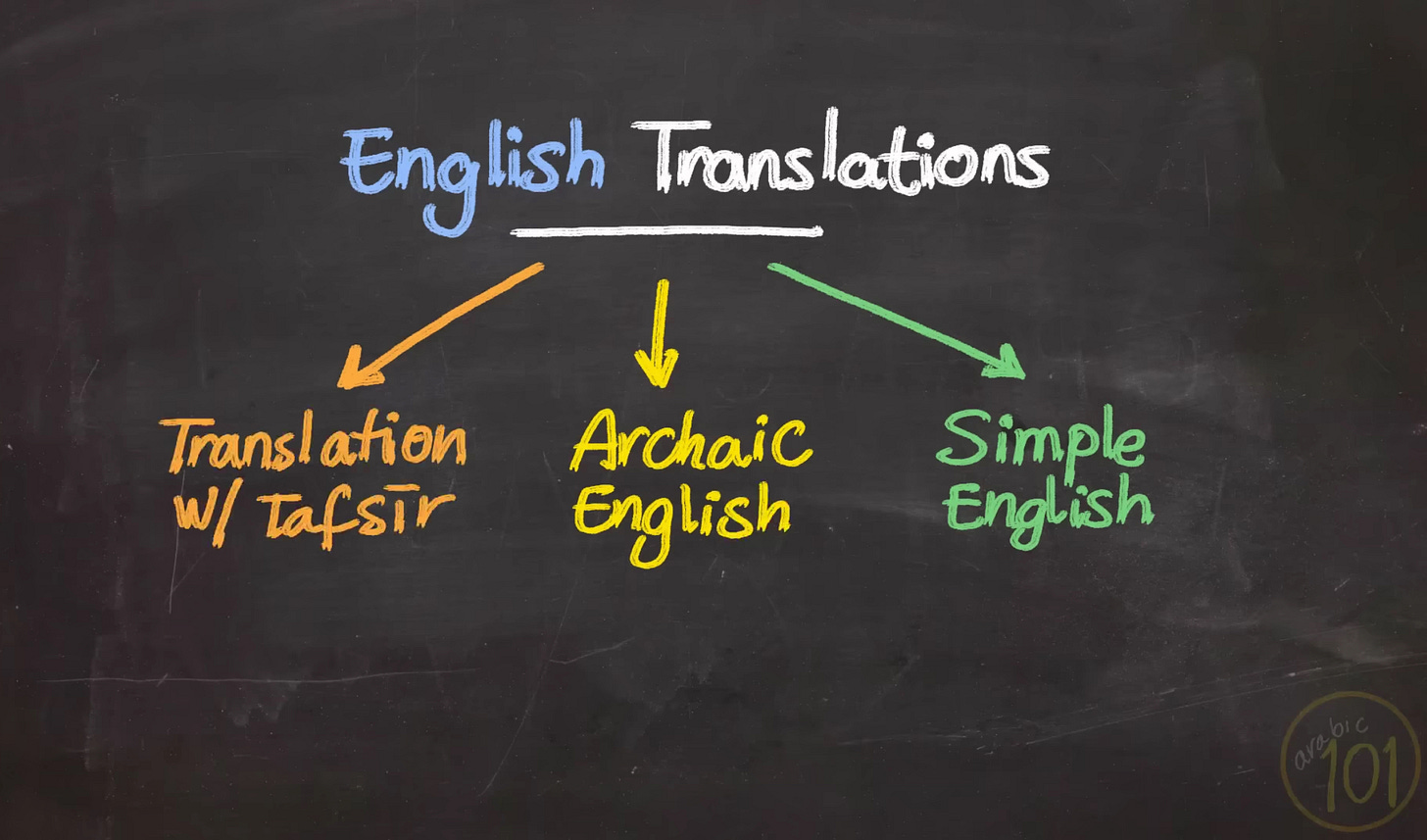Navigating the Sea of Quran Translations: What to Choose and What to Avoid
Learn how to choose an accurate, clear, and reliable English translation of the Quran for deeper understanding.
Assalamu Alaikum Everyone,
As we embark on our journey to better understand the Quran, it’s crucial to first recognize the challenge ahead. With over 150 English translations available, the sheer number can leave us wondering which one to choose. It’s important to remember that not all translations are the same, nor do they all serve the same purpose. In fact, not all are equally accurate or reliable. In this post, we’ll explore the different types of translations you’ll encounter, highlight some you should consider, and point out others you may want to avoid.
The English translations of the Quran today generally fall into three categories: Simple English, Archaic English, and English with Tafsir. Simple English uses modern language to explain each ayah, making it the most direct and accessible for understanding the message. For example, Sahih International is commonly used in our lessons due to its clarity, revision, and wide acceptance. This translation often adds context to address ambiguities in the English language, making it easier for readers to follow. If you're looking for a simpler yet direct translation without added context, Clear Quran (Talal Itani) could be a good choice. Though it is less precise, it remains a solid option. On the other hand, some translations, such as those by Ahmad Raza Khan and Ahmad Ali, should be avoided. These translations either distort meanings or push particular ideologies, altering the true message of the Quran to fit a specific agenda.
Archaic English translations use older forms of the language, which can make the text feel more unique and formal. These versions often incorporate words and phrases that are no longer in common use, such as "thou," "thee," "lo," and "verily." While some readers may appreciate this older, more poetic style, it can be challenging for younger or modern readers who are not accustomed to such vocabulary. If you enjoy this style, Muhammad Pickthall's translation is highly regarded, praised for its accuracy and its careful balance between traditional English and the original Arabic. However, certain archaic translations should be approached with caution. Yusuf Ali’s translation, for example, has faced criticism for numerous errors, including issues with aqeedah (doctrinal beliefs) and fiqh (jurisprudence) interpretations, making it a controversial choice. Another translation to avoid is that of Arthur Arberry, an orientalist who was not Muslim. His work represents his own understanding of the Quran rather than an authentic representation of its message, which may lead to a skewed or inaccurate interpretation. When choosing an archaic English translation, or any English translation for that matter, it’s crucial to prioritize accuracy and scholarly integrity, as some translations may unintentionally lead readers astray in terms of understanding key concepts.
Translations with Tafsir go beyond a simple translation, incorporating commentary and explanations to help the reader better understand the context and deeper meanings of the verses. These translations are often longer because they include additional insights that clarify ambiguities or provide historical and theological background. The most popular translation in this category is by Hilali and Khan, which includes extended notes and explanations, with a focus on content over eloquence. While this translation is comprehensive, it may not read as smoothly as others, as it blends the translation with detailed commentary.
These are the three main categories of Quran translations and some of the best options within each. By understanding the differences between them, you can choose the translation that best suits your needs, whether you're looking for simplicity, traditional language, or in-depth explanation.
There is also a newer translation that stands out from the rest, The Bridges Translation. What makes this translation unique is its ability to allow readers to deeply ponder the Quran without needing to know Arabic. It achieves this in three key ways. First, it closely mimics the feel of the original Arabic by using creative solutions to overcome the limitations of the English language, capturing both the emotional and rhetorical power of the Quranic text. Second, it incorporates the Ten Qira’at, or modes of Quranic recitation, which is not found in any other translation. These variations are highlighted in the footnotes, offering readers a comprehensive understanding of the different nuances in meaning behind each verse. Finally, the translation includes thoughtful hints and notes designed to encourage reflection on Allah’s choice of words, helping readers think deeply about the divine wisdom embedded in the Quran. Overall, The Bridges Translation provides all the tools necessary to engage with the Quran’s message on a profound level, allowing readers to appreciate its beauty and wisdom without being Arabic speakers.
If you truly wish to experience the Quran in its purest form and fully appreciate Allah’s choice of words as they were revealed, learning Arabic is essential. While translations can help us understand the message, they can never fully capture the depth, beauty, and nuances of the original Arabic text. The effort to learn Arabic is undoubtedly worth it, as it allows you to engage with the Quran in the most authentic way. Inshallah, may this journey be made easy for you, and may we all be granted the knowledge and understanding to truly grasp the divine wisdom contained in His words. Ameen.
Jazakum Allah Khayran for reading. If you enjoyed the read, don’t forget to hit the like button and help share it with other Muslims. Links to the referenced video are below along with other links to help you get started on your journey to learning Arabic.





Very informative
May ALLAH bless you and the entire team, including the viewers.
Ameen.